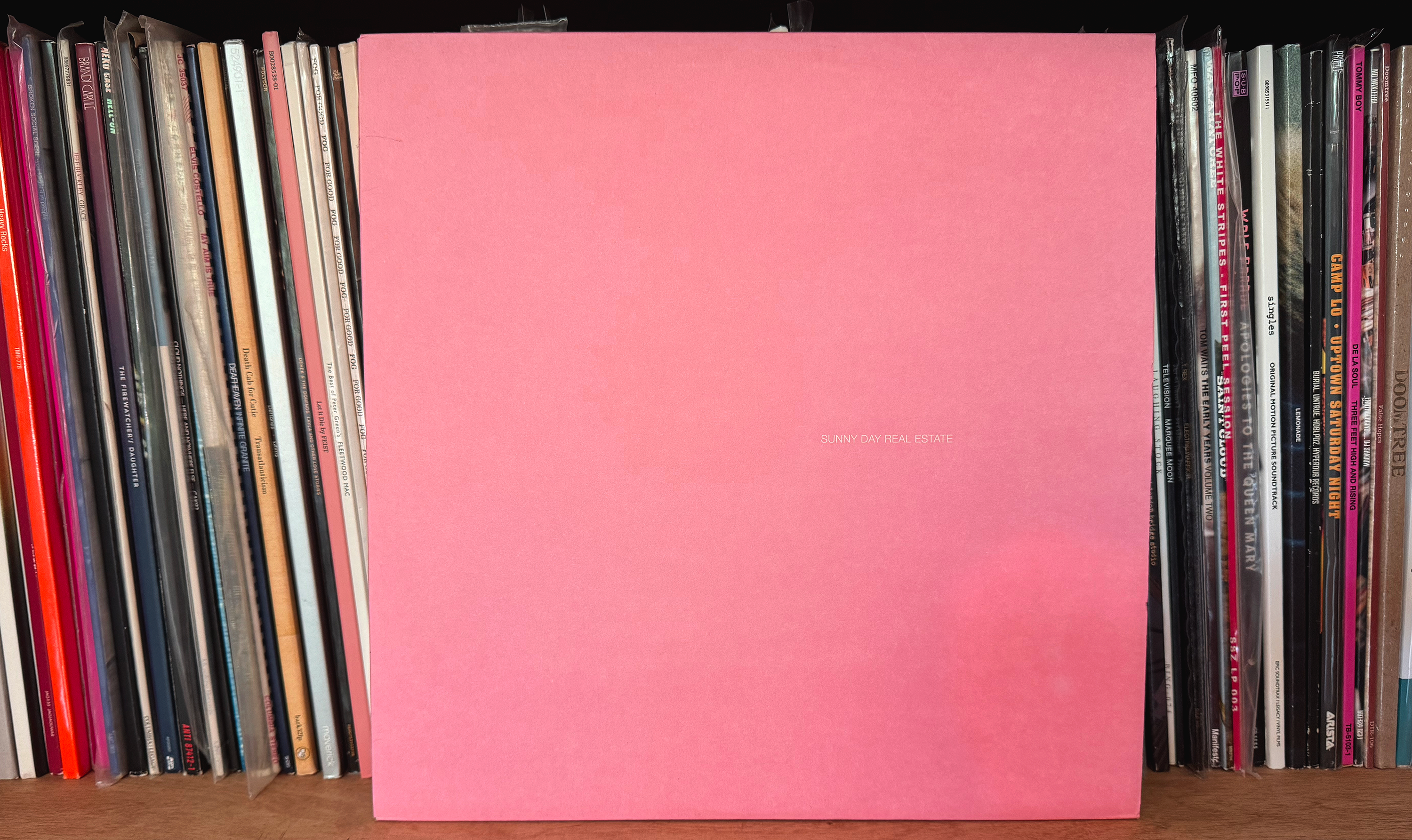
First Anniversary
Published on Dec 17, 2025
Introducing: The IHTOV Zine
Published on Dec 15, 2025
Christmas Music Selections
Published on Dec 14, 2025
The Beastie Boys and Me
Published on Dec 10, 2025
More Liner Notes…
Featured Essay: Sunny Day Real Estate Never Finished their Second Album and It’s Perfect
by Steve McPherson

It’s possible to take the story around an album’s creation as nothing but window dressing, as fodder for PR efforts. Not every album has a story worth telling, and not every one that does can make the album bigger or deeper. Sometimes the circumstances of an album’s creation are merely coincidental to the thing itself. But sometimes, it’s essential to how it blooms in our understanding.
Consider an album that doesn’t even have a proper name. Following the release of their debut album Diary in May of 1994 and the subsequent tour, Seattle’s Sunny Day Real Estate returned to the studio to begin work on their next album. For context, their tour wrapped in December 1994 and the album would come out in November 1995. Not a very big window of time.
While critically revered and influential now, Diary had not been a smash. 1994 saw the death of Kurt Cobain, the release of Pearl Jam’s third album Vitalogy and — on the same day as Sunny Day’s debut — the release of Weezer’s debut album, which would go on to bring thick and geeky power-pop back to MTV and the airwaves. Sunny Day Real Estate had neither the gruff, muscular brooding of Pearl Jam, nor the blistering but fun self-awareness of Weezer.
What they had was the template for what would become — for better or worse — emo. Dark and miserable, then soaring and cathartic, singer/guitarist Jeremy Enigk’s keening wail paired with the post-punk backing of guitarist Dan Hoerner, bassist Nate Mendel and drummer William Goldsmith in an almost alchemical way. There could be few clearer manifestos than Enigk’s line from “In Circles”: “I dream to heal your wounds / but I bleed myself.”
Enigk was young, almost ridiculously so: 19 when Diary was written and recorded and 20 when they began work on the second album. The rest of the band were all three to six years older but it was Enigk’s voice — both literally and on paper — that made the band stand out. Somewhere in all this, Enigk went through what he calls a “major spiritual explosion.” By all accounts, there was no one definitive thing that broke the band up, but sometime before they finished their second album, they were done.
“The songs were really strong,” said Hoerner in the liner notes for the 2009 reissue of the album, “but there were internal pressures that were driving the band apart. We had come to the realization that we’d done our last tour, but we wanted to finish the record, and we wanted it to be good.”
The sum total of what they had accomplished amounted to six new songs, two re-recorded Diary-era songs, and one unused B-side. Nine total tracks, no artwork and incomplete vocals. “On a lot of songs, there aren’t lyrics,” said Enigk. “In a lot of cases, we never sat down to write them, because we just wanted to get it out of the way as fast as possible. So I just sang a lot of gibberish.” When their label Sub Pop contacted Goldsmith about putting the album out, he told them to make it pink. They did, and thus did a record called variously Sunny Day Real Estate, or “the pink album” or LP2 (how it was referred to in their contract with Sub Pop) come into the world.
But it stands out from other incomplete albums because its vibe is not unfinished — at least not initially. Instead, it feels cryptic. The titles are either evocative and without referent — “Friday,” “Red Elephant,” “Waffle” — or bluntly descriptive — “5/4” is in, well, 5/4 — or bear the marks of their leftover status —”8” was one of the songs initially recorded during the Diary sessions and written after that album’s opener “Seven.”
And then there are those gibberish lyrics, often whispered and just lightly skimming the surface like conversation from another room. Overheard: “There was a time when running / I went swimming / And you pulled me to come back” and “We climbed the wreck / cold diamond (hammer?) heart” and “One (A?) pumpkin knife to pry out our hands on plastic wounds.” By Enigk’s own account, the true words of a song are the last piece of the puzzle to drop for him and so here we find their antecedents. What begins as an inchoate vocal melody finds its way into words but the meaning comes trailing along behind.
Then there’s the music. Odd time signatures abound: 5/4, 9/8, a measure of 7/8 slammed up against a reassuring measure of 4/4. Things happen a weird number of times — a chorus twice through the first time and three times the next. An extra measure seems added to shore up a transition until it can be truly fixed later. “The songs are a little bit more like parts being welded together, instead of being cohesive wholes,” said Mendel. You begin to find the seams when you dig in.
Take “J’Nuh.” The unsteady stairstep guitar figure that starts it is in G Lydian — which means major with the fourth note of the scale raised a half-step, putting the notorious tritone directly into the heart of the melodic figure. The vocal melody follows it, but only at first. The third time through it takes a different route, eventually landing a half-step off from the guitar, wrongfooting the whole thing.
Nothing on Diary adequately prefigures the bludgeoning but somehow melodically essential drums of the chorus of “Red Elephant.” “Waffle” begins with ominous arpeggiated guitars and a slow-motion neverending drum fill before suddenly breaking off into a lilting melody played high up on the bass, like sunlight breaking through cloud cover.
“Iscarabaid” could be a made up character like Astiocles, a Greek god with a prodigious capacity for drinking that Enigk created for “The Blankets Were the Stairs” on Diary. It could be a fictional substance, like the darium that would bind stones in the leadoff track “Pillars” from their 1998 album How It Feels to Be Something On. It seems to reference “iscariot,” the epithet meaning “a person who betrays another” that was given to Judas in the bible. It also might include the word “scarab,” referencing Egyptian mythology — a symbol of resurrection. These could all be pieces of the puzzle, but it’s far more likely they’re just pieces of different puzzles, scattered on the floor for you to try to put together.
The track begins with the two guitars and bass talking over each other — none are clearly defining chords and they almost seem to be playing entirely different songs simultaneously. When Enigk’s vocals arrive, they sound like they’re coming out of cupped hands. It’s cold and dark and eerie and beautiful, and as it inches into the pre-chorus, the chiming high chords that floated above the verse begin to slash down against the earth like intermittent peels of thunder. And then just when it seems the storm has cleared, the chorus unleashes a deluge — a crackling lead vocal pressed against a gang vocal intoning the song’s title again and again, a ghostly moan that doesn’t really register as the title at all, buried as it is inside the song.
Craig Wedren, guitarist and singer of one of Sunny Day’s major influences Shudder to Think, said of the album, “There’s a fine line between profane ecstasy and spiritual transcendence. Obviously what they were interested in was walking that fine line. It was fuzzy for them.” And so the album’s creation — a young band stumbling through the process despite knowing it was all ending — and final, half-finished form reflect and amplify the core concerns of the music itself. This is restless music, seeking and in search of but never satisfied. In laboring against the frailty of the creative process, it ultimately venerates it.
There’s a tendency to think of the creative act as one that moves from nothingness to form, from chaos to order, from lack to fulfillment. We undertake a project and refine it until it is complete, finished. But there is nevertheless accomplishment in the partially completed, the bones laid bare, stuck forever in the act of becoming. LP2 asks us to try to complete it even if we can’t, to impress our own meanings into its soft flesh over and over again.
.
Steve McPherson is a musician and writer living in Minneapolis, Minnesota. His writing about music and basketball has appeared in Rolling Stone, the New York Times, the New Yorker, Grantland and other publications. His Sunny Day Real Estate tribute band, In Circles, will perform LP2 in its entirety on Saturday, November 15 at the White Squirrel Bar in Saint Paul, Minnesota. Follow him on BlueSky

